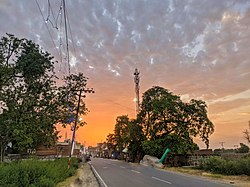world.wikisort.org - India
Kasganj district is a district of the Indian state Uttar Pradesh. It is located in the division of Aligarh and consists of Kasganj, Patiali and Sahawar tehsils. Its headquarters is at Kasganj.[1]
Kasganj district
कासगंज जनपद | |
|---|---|
District of Uttar Pradesh | |
 Sunset in Bilram | |
 | |
| Coordinates: 27.82°N 78.65°E | |
| Country | |
| State | Uttar Pradesh |
| Division | Aligarh |
| Headquarters | Kasganj |
| Area | |
| • Total | 1,993 km2 (770 sq mi) |
| Population (2011) | |
| • Total | 1,436,719 |
| • Density | 720/km2 (1,900/sq mi) |
| Languages | |
| • Official | Hindi |
| Time zone | UTC+5:30 (IST) |
| ISO 3166 code | IN-UP-KN |
| Literacy | 62.3% |
| Website | https://kasganj.nic.in/ |
History
The district lies in the cultural region of Braj. Kasganj was established on 15 April 2008 by separating Kasganj, Patiali and Sahawar tehsils from Etah district. For a while, the district was named after a politician, Kanshi Ram. The decision taken by Mayawati, chief minister of Uttar Pradesh and president of the BSP provoked protests by lawyers who had proposed to call it in honor of Sant Sant Tulsidas, who was born in the district, that place known as Soron (Sukarkshetra).[2] The district reverted to its original name in 2012.[3] Adjacent districts of Kasganj are Aligarh, Budaun, Etah, Farrukhabad and Khair Tehsil.
Demographics
According to the 2011 census Kasganj district has a population of 1,436,719,[5] roughly equal to the nation of Eswatini[6] or the US state of Hawaii.[7] This gives it a ranking of 345th in India (out of a total of 640).[5] The district has a population density of 736 inhabitants per square kilometre (1,910/sq mi).[5] Its population growth rate over the decade 2001–2011 was 17.05%.[5] Kanshiram Nagar has a sex ratio of 879 females for every 1000 males,[5] and a literacy rate of 62.3%. Scheduled Castes make up 17.70% of the population.[5]
At the time of the 2011 Census of India, 91.45% of the population in the district spoke Hindi and 8.27% Urdu as their first language.[8] The local languages are Brajbhasha and Kannauji.
| Year | Pop. | ±% p.a. |
|---|---|---|
| 1901 | 386,383 | — |
| 1911 | 389,747 | +0.09% |
| 1921 | 371,135 | −0.49% |
| 1931 | 384,897 | +0.36% |
| 1941 | 440,490 | +1.36% |
| 1951 | 502,930 | +1.33% |
| 1961 | 588,879 | +1.59% |
| 1971 | 699,806 | +1.74% |
| 1981 | 826,616 | +1.68% |
| 1991 | 991,289 | +1.83% |
| 2001 | 1,228,705 | +2.17% |
| 2011 | 1,436,719 | +1.58% |
| source:[9] | ||
See also
- Dholna
References
- "Kanshiram Nagar to be State's 71st district". Archived from the original on 13 May 2009. Retrieved 20 May 2015.
- Lawyers against naming new Kasganj district after Kanshi Ram
- "Important Cabinet Decisions". Lucknow: Information and Public Relations Department. Retrieved 17 January 2013.
- "Table C-01 Population by Religion: Uttar Pradesh". censusindia.gov.in. Registrar General and Census Commissioner of India. 2011.
- "District Census 2011". Census2011.co.in. 2011. Retrieved 30 September 2011.
- US Directorate of Intelligence. "Country Comparison:Population". Archived from the original on 13 June 2007. Retrieved 1 October 2011.
Swaziland 1,370,424
- "2010 Resident Population Data". U. S. Census Bureau. Archived from the original on 1 January 2011. Retrieved 30 September 2011.
Hawaii 1,360,301
- "Table C-16 Population by Mother Tongue: Uttar Pradesh". www.censusindia.gov.in. Registrar General and Census Commissioner of India.
- Decadal Variation In Population Since 1901
External links
На других языках
[de] Kasganj (Distrikt)
Der Distrikt Kasganj (Hindi कासगंज ज़िला, Urdu ضلع کانسی رام نگر), von 2008 bis 2012 Distrikt Kanshiram Nagar, ist ein Distrikt im nordindischen Bundesstaat Uttar Pradesh. Verwaltungssitz ist die Stadt Kasganj.- [en] Kasganj district
[ru] Канширамнагар
Канширамнагар (англ. Kanshi Ram Nagar) — округ в индийском штате Уттар-Прадеш. Создан 15 апреля 2008 года из части территории округа Этах. Назван в честь индийского политика Канши Рама. Административный центр — город Касгандж. Площадь округа — 1,993 км². Согласно всеиндийской переписи 2001 года население округа составляло 1 228 705 человек.Другой контент может иметь иную лицензию. Перед использованием материалов сайта WikiSort.org внимательно изучите правила лицензирования конкретных элементов наполнения сайта.
WikiSort.org - проект по пересортировке и дополнению контента Википедии